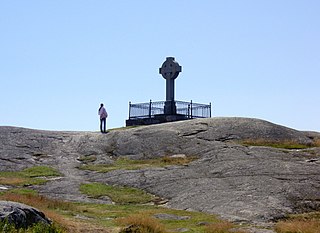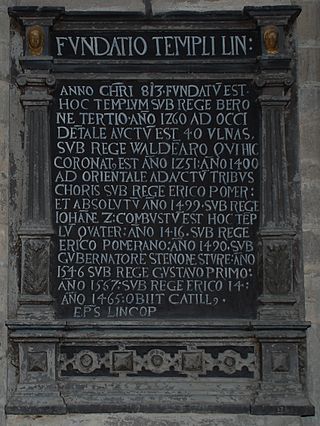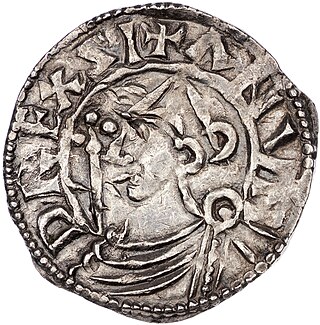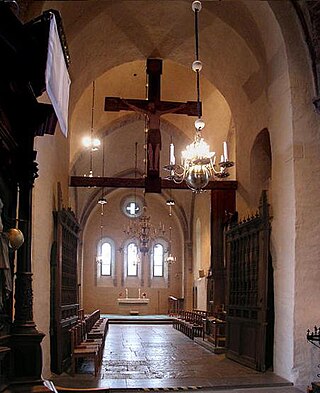Related Research Articles

Birka, on the island of Björkö in present-day Sweden, was an important Viking Age trading center which handled goods from Scandinavia as well as many parts of the European continent and the Orient. Björkö is located in Lake Mälaren, 30 kilometers west of contemporary Stockholm, in the municipality of Ekerö.

Olof Skötkonung, sometimes stylized as Olaf the Swede, was King of Sweden, son of Eric the Victorious and, according to Icelandic sources, Sigrid the Haughty. He succeeded his father in c. 995. He stands at the threshold of recorded history, since he is the first Swedish ruler about whom there is substantial knowledge. He is regarded as the first king known to have ruled both the Swedes and the Geats. In Sweden, the reign of king Olov Skötkonung is considered to be the transition from the Viking age to the Middle Ages, because he was the first Christian king of the Swedes, who were the last to adopt Christianity in Scandinavia. He is associated with a growing influence of the church in what is today southwestern and central Sweden. Norse beliefs persisted in parts of Sweden until the 12th century.

Eric the Victorious was a Swedish monarch as of around 970. Although there were earlier Swedish kings, he is the first Swedish king in a consecutive regnal succession, who is attested in sources independent of each other, and consequently Sweden's list of rulers usually begins with him. His son Olof Skötkonung, however, is considered the first ruler documented to definitely have been accepted both by the original Swedes around Lake Mälaren and by the Geats around Lake Vättern. Adam of Bremen reports a king named Emund Eriksson before Eric, but it is not known whether he was Eric's father. The Norse sagas' accounts of a Björn Eriksson are considered unreliable.
Emund Eriksson, , was a Swedish king whose historicity is only known from a single source, the Gesta Hammaburgensis ecclesiae pontificum which was written by Adam of Bremen in c. 1075.
Anund Uppsale or Anoundus, 'Anund of Uppsala',, a son of Erik Björnsson of the House of Munsö, ruled Sweden together with his brother Björn at Haugi, according to Hervarar saga. He is called Uppsale because he stayed at Old Upsala, the era's religious centre. He and Björn are sometimes identified with similarly-named kings mentioned in Rimbert's Vita Ansgari and by Adam of Bremen.
Olof was a Swedish monarch or local ruler who ruled over Birka, an important port town, and possibly Uppsala, an important early Swedish political center, in about 852, when the Catholic missionary Saint Ansgar made his second voyage from Germany to Birka in about the year 851 or 852 A.D. He had an ambivalent attitude to Christianity, and was known as a successful warrior king in the Baltic region.

Björn according to the Hervarar saga and Harald Fairhair's saga was the father of Olof (II) Björnsson and Eric the Victorious, also a grandfather of Styrbjörn the Strong. According to the two sagas, he was the son of an Erik who fought Harald Fairhair and who succeeded the brothers Björn at Hauge and Anund Uppsale:
Eric Anundsson or Eymundsson was a semi-legendary Swedish king who supposedly ruled during the 9th century. The Norse sagas describe him as successful in extending his realm over the Baltic Sea, but unsuccessful in his attempts of westward expansion. There is no near-contemporary evidence for his existence, the sources for his reign dating from the 13th and 14th centuries. These sources, Icelandic sagas, are generally not considered reliable sources for the periods and events they describe.
Ring was a Swedish monarch or local ruler who ruled at Uppsala, an important early Swedish political center, around or before the year 936. He either ruled before or together with his two sons Eric and Emund. Virtually nothing is known about him beyond his name.

The House of Munsö, also called the House of Björn Ironside, the House of Uppsala or simply the Old dynasty, is the earliest reliably attested royal dynasty of Sweden, ruling during the Viking Age. None of the names suggested for the dynasty are universally accepted and most are problematic; the name "House of Munsö" derives from a questionable and speculative theory that they would have ruled from the island of Munsö and the name "House of Björn Ironside" derives from the supposed founder of the dynasty, Björn Ironside, who is often seen as a legendary, rather than historical, figure.

Anund Jacob or James was King of Sweden from 1022 until around 1050. He is believed to have been born on July 25, in either 1008 or 1010 as Jakob, the son of King Olof Skötkonung and Queen Estrid. Being the second Christian king of the Swedish realm, his long and partly turbulent reign saw the increasing dissemination of Christianity as well as repeated attempts to influence the balance of power in Scandinavia. Throughout his reign, he tried to subvert the rising Danish hegemony in Scandinavia by supporting the Norwegian monarchy. He also supported the reign of Yaroslav the Wise in Kievan Rus, his brother-in-law. He is referred to in positive terms in German and Norse historical sources. His reign was one of the longest in Sweden during the Viking Age and Middle Ages.
Emund the Old or Edmund was King of Sweden from c. 1050 to c. 1060. His short reign was characterised by disputes with the Archbishopric of Bremen over church policies, and a historically debated delimitation of the Swedish-Danish border.

Stenkil was a King of Sweden who ruled c. 1060 until 1066. He succeeded Emund the Old and became the first king from the House of Stenkil. He is praised as a devout Christian, but with an accommodating stance towards the old Pagan religion. His brief reign saw an armed conflict with Norway.
Olof was, according to Adam of Bremen, a Swedish chieftain who conquered Denmark c. 900 and founded the House of Olaf. Evidence for his historicity is only circumstantial, since he belongs to a period of Danish history when very little is known from textual sources.

Saint Sigfrid of Sweden (Swedish: Sigfrid, Latin: Sigafridus, Old Norse: Sigurðr, Old English: Sigefrið/Sigeferð) was a missionary-bishop in Scandinavia during the first half of the 11th century. Originally from England, Saint Sigfrid is credited in late medieval king-lists and hagiography with performing the baptism of the first steadfastly Christian monarch of Sweden, Olof Skötkonung. He most likely arrived in Sweden soon after the year 1000 and conducted extensive missions in Götaland and Svealand. For some years after 1014, following his return to England, Sigfrid was based in Trondheim, Norway. However, his position there became untenable after the defeat of Olaf Haraldsson.
Gunnhildr Sveinsdóttir or Gunnhildr Haraldsdóttir, Guda or Gyda was, according to the traditional view, a queen consort of King Anund Jacob of Sweden and of king Sveinn II of Denmark. However, the sources are so vague that several modern historians maintain that there were actually two queens of that name, of Sweden and Denmark respectively. She is sometimes called Gude or Gyridje, but this is probably because of confusion with her daughter, Gyda, who is also known under her mother's name Gunnhildr.
Astrid Njalsdotterof Skjalgaätten, was a Norwegian noblewoman who married Ragnvald the Old and became the ancestress of the Swedish Stenkil dynasty. She is sometimes assumed to have been a Swedish queen, though the evidence is inconclusive.
Eric and Eric, according to Adam of Bremen, were two contenders for the kingship of Sweden around 1066–67, after the death of King Stenkil. They waged war on each other, with disastrous consequences: "[I]n this war all the Swedish magnates are said to have fallen. The two kings also perished then. When the entire royal clan was thus entirely extinct, conditions in the kingdom were changed and Christianity was disturbed to a high degree. The bishops that the Archbishop [of Bremen] had anointed for this land stayed back home due to fear of persecutions. Only the bishop in Scania took care of the churches of the Geats, and the Swedish Jarl Gnif strengthened his people in the Christian faith."
References
- ↑ Carl Bernadotte et al. (eds) (1956), Sveriges hundra konungar. Stockholm: Biblioteksböcker, p. 93.
- ↑ Adam av Bremen (1984), Historien om Hamburgstiftet och dess biskopar. Stockholm: Proprius förlag, p. 57-8 (Book I, Chapters 57-59).
- ↑ Adam av Bremen (1984), p. 60 (Book I, Chapter 61).
- ↑ Adam av Bremen (1984), p. 62 (Book I, Chapter 62).
- ↑ Adam av Bremen (1984), p. 81 (Book II, Chapter 25).
- ↑ Carl Bernadotte et al. (eds) (1956), p. 93.
- ↑ Nordisk familjebok, 2nd edition http://runeberg.org/nfbc/0322.html